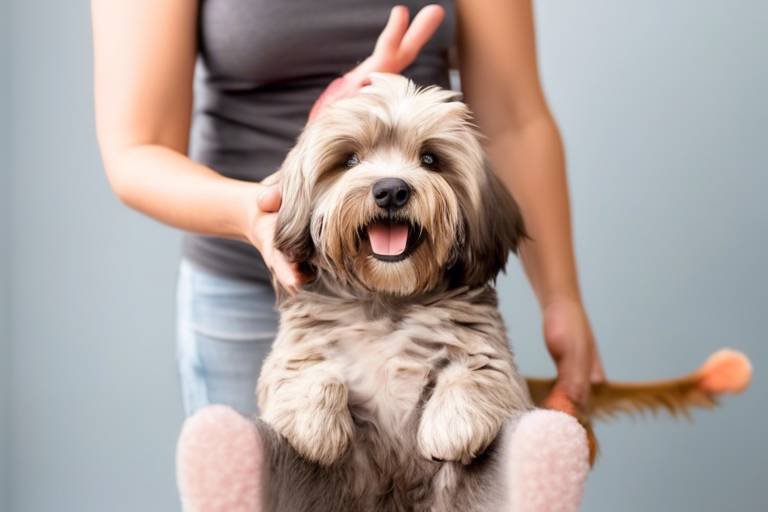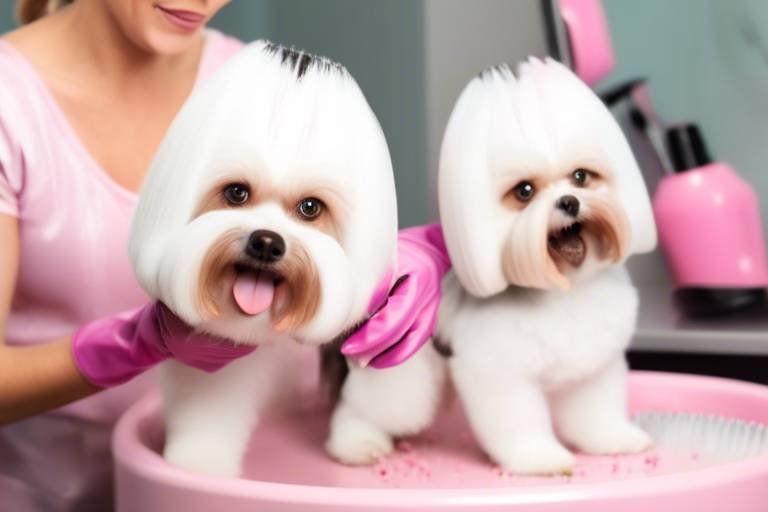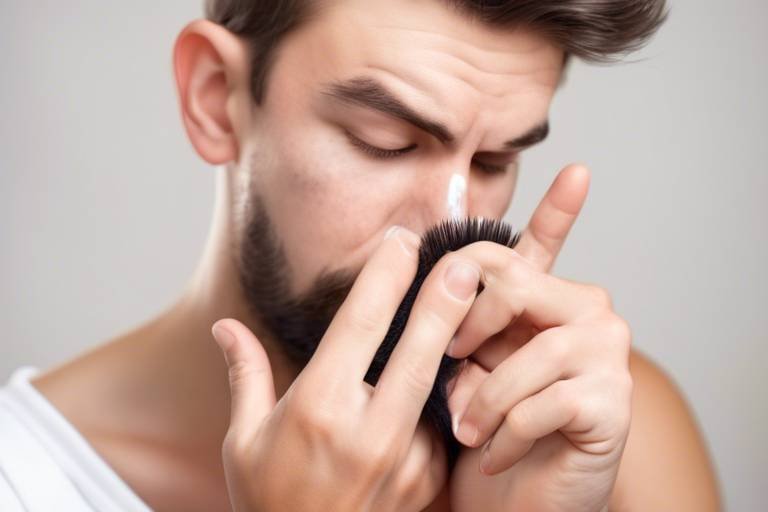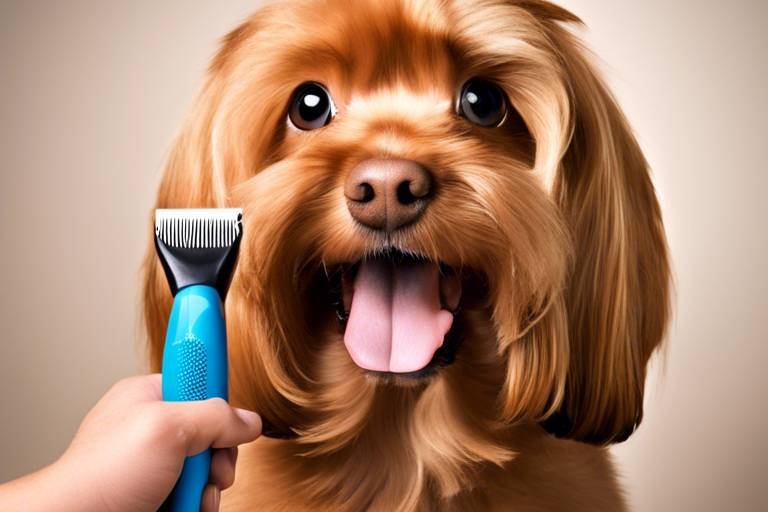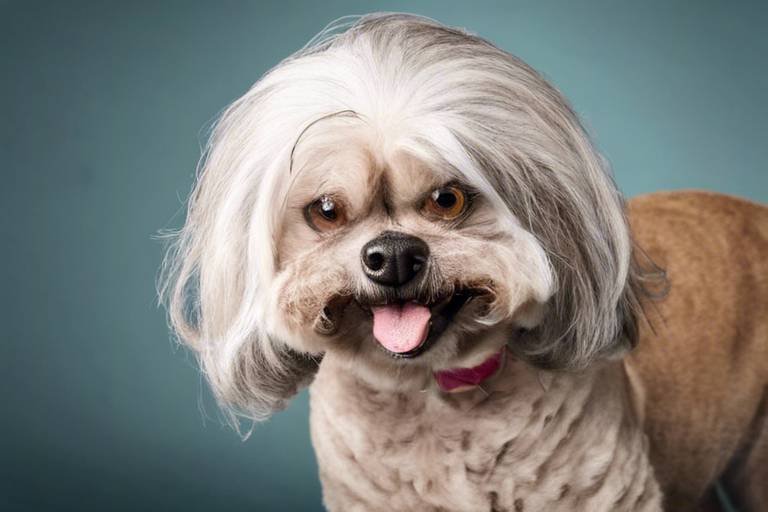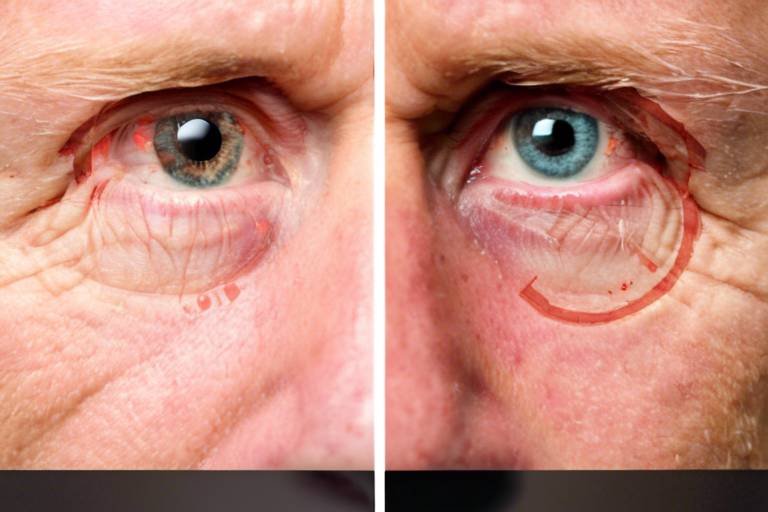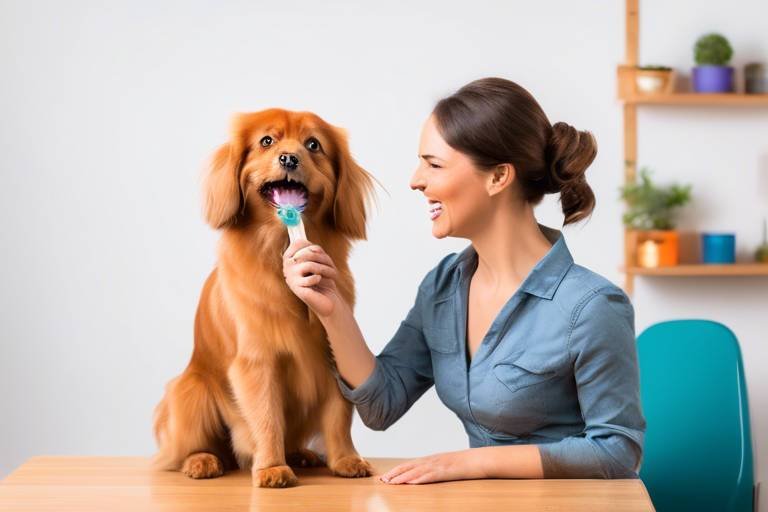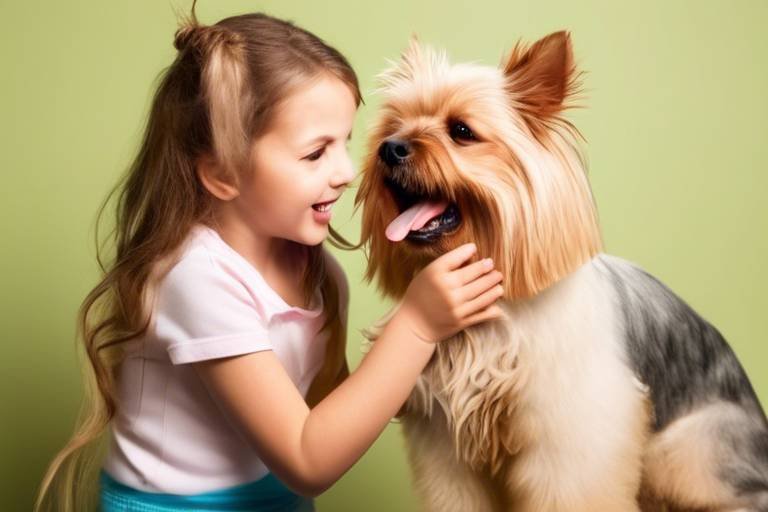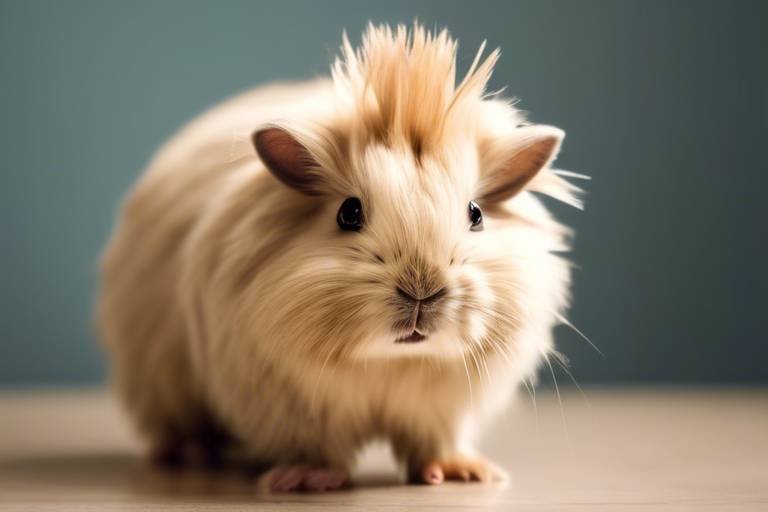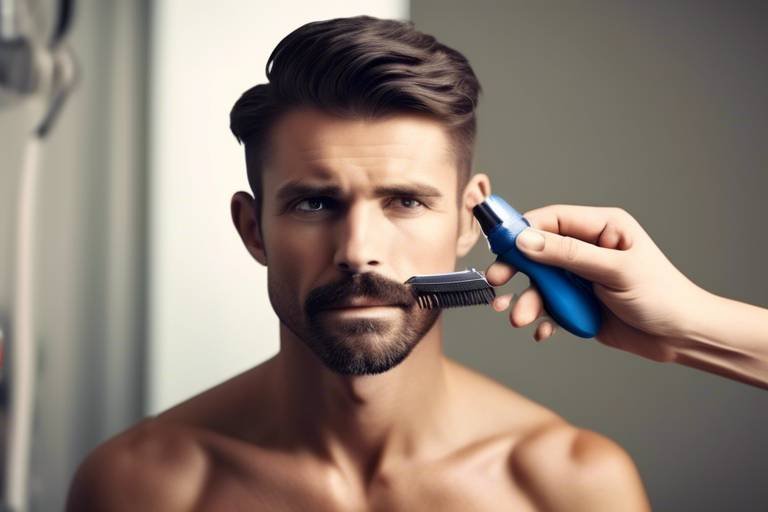How to Teach Your Dog to Hold Still During Grooming
Grooming your dog can sometimes feel like trying to catch a greased pig! If your furry friend is always squirming, barking, or trying to escape, it can turn a simple task into a real challenge. But don't worry, you’re not alone! Many pet owners face this dilemma. The good news is that with a little patience, understanding, and the right techniques, you can teach your dog to hold still during grooming sessions. This article will guide you through essential tips and techniques that will not only make grooming easier but also create a more positive experience for both you and your pet.
Before diving into training, it's crucial to understand why your dog might be restless during grooming. Is it fear of the clippers? Anxiety about being handled? Or perhaps they just don't like being still? Recognizing these behaviors can help you tailor your approach. For instance, if your dog is afraid of the sound of the clippers, you might want to introduce the clippers in a non-threatening way, allowing your dog to sniff and investigate them when they are turned off. This understanding is the first step in addressing their specific needs and anxieties during grooming.
Creating a calm and inviting grooming space is essential for helping your dog feel secure and relaxed. Think of this space as your dog's personal spa! A positive environment can significantly influence their behavior. Let’s explore how to set the stage for a successful grooming experience.
Selecting a familiar and quiet area for grooming can minimize distractions. Choose a spot in your home where your dog feels comfortable and safe. This could be a corner of the living room or a designated grooming area. The key is to ensure that it’s a place where your dog can relax and not feel overwhelmed by new sights or sounds.
Imagine trying to concentrate on a task while loud music or shouting is going on around you. It’s nearly impossible! The same goes for your dog. Reducing background noise and keeping the area free from interruptions can help your dog focus better. Consider using soft music to create a calming atmosphere. This can transform the grooming session from a stressful chore into a soothing experience.
Investing in high-quality and comfortable grooming tools can make a world of difference. Just like you wouldn’t want to use a scratchy brush on your own hair, your dog deserves the same comfort. Look for tools that are designed for your dog’s specific breed and coat type. This not only reduces anxiety but also encourages them to hold still, knowing that they are in capable hands.
Establishing a trusting relationship with your dog is crucial for successful grooming. Think of it as building a bridge between you and your pet. Positive reinforcement techniques, such as treats and praise, can foster this bond. When your dog associates grooming with rewards, they are more likely to remain calm and still. Remember, trust is built over time, so be patient and consistent in your approach.
Now that you’ve set the stage, let’s dive into some effective training techniques that can help your dog learn to stay still during grooming. These methods are not only practical but can also be fun for both of you!
Using treats and praise as rewards can work wonders. Every time your dog holds still for a few moments, shower them with praise or a tasty treat. This encourages them to repeat the behavior. It’s like giving them a little high-five for being a good pup! Over time, they will learn that staying still during grooming leads to positive outcomes.
Gradually introducing your dog to grooming tools and techniques can help reduce their anxiety. Start by letting your dog get used to the sight and sound of the grooming tools while they’re turned off. Once they seem comfortable, you can slowly introduce the tools while grooming them in short sessions. This method allows your dog to become more comfortable with the grooming process over time, reducing their fear and anxiety.
Creating a consistent grooming schedule can help your dog become accustomed to the process. Just like you have your morning routine, your dog will thrive on predictability. A regular schedule makes it easier for them to hold still during each session.
Determining the appropriate frequency for grooming based on your dog's breed and coat type is essential. Some dogs may need grooming every few weeks, while others might only need it monthly. Understanding your dog's specific needs can help maintain their comfort and reduce anxiety during sessions.
Including playtime and breaks during grooming can help your dog associate the experience with fun. Think of it as a mini-adventure rather than a chore. Allowing your dog to take breaks to play with their favorite toy or receive cuddles can make the grooming process more enjoyable and less stressful.
- How long should grooming sessions last? Start with short sessions of about 5-10 minutes and gradually increase the time as your dog becomes more comfortable.
- What should I do if my dog continues to resist grooming? If your dog is still anxious, consider consulting a professional groomer or a dog trainer for additional support.
- Can I groom my dog at home? Absolutely! With the right tools and techniques, you can create a positive grooming experience at home.

Understanding Your Dog's Behavior
When it comes to grooming your furry friend, understanding their behavior is crucial. Just like us, dogs have their own set of emotions and reactions that can influence how they behave during grooming sessions. Have you ever noticed your dog fidgeting or trying to escape when you bring out the grooming tools? This restlessness often stems from anxiety or fear, and recognizing these triggers can help you tailor your training approach. For instance, some dogs may have had negative experiences in the past, leading them to associate grooming with discomfort. Others might simply be overwhelmed by the sensations of being brushed or clipped.
It's essential to observe your dog's body language closely. Signs of stress can include:
- Tucked tails
- Whining or barking
- Excessive licking or yawning
- Pacing or trying to escape
Each of these behaviors can signal that your dog is feeling uneasy. By being aware of these signs, you can adjust your approach to make grooming more enjoyable for both of you. For example, if your dog seems particularly anxious about the sound of clippers, you might want to introduce the tool gradually, allowing them to sniff it and get used to the noise before you even attempt to use it.
Additionally, consider the breed and personality of your dog. Some breeds are naturally more anxious than others, while certain dogs may have specific quirks that affect their behavior during grooming. For example, a high-energy dog may struggle to hold still simply because they have a lot of pent-up energy. Understanding your dog's unique personality traits can help you develop a more effective grooming strategy. It’s like trying to solve a puzzle; the more pieces you have, the clearer the picture becomes.
In summary, recognizing the reasons behind your dog's restlessness can significantly improve your grooming experience. By observing their body language and understanding their past experiences, you can create a training plan that addresses their specific needs and anxieties. This understanding lays the foundation for a more relaxed grooming session, allowing you and your dog to enjoy the process together.
- Why does my dog hate grooming?
Many dogs dislike grooming due to past negative experiences, unfamiliar sensations, or anxiety about the tools being used. - How can I tell if my dog is stressed during grooming?
Look for signs like a tucked tail, excessive licking, or attempts to escape. These behaviors indicate discomfort. - What can I do to make grooming easier for my dog?
Establish a calm environment, use positive reinforcement, and gradually introduce grooming tools to reduce anxiety.

Creating a Positive Environment
When it comes to grooming your dog, the environment you create plays a critical role in how your furry friend responds to the process. Imagine trying to relax in a chaotic room filled with loud noises and distractions; it’s nearly impossible, right? Your dog feels the same way! By establishing a calm and inviting grooming space, you're setting the stage for a more pleasant experience. This not only helps your dog feel secure but also makes the grooming process smoother for you.
First and foremost, choosing the right location is essential. Look for a familiar area in your home where your dog feels comfortable. This could be a quiet corner of the living room or even a designated grooming space in the bathroom. The key is to minimize distractions, allowing your dog to focus on the task at hand. If your dog is used to being groomed in a specific spot, they will start to associate that location with positive experiences, making them less anxious over time.
Another important factor is reducing background noise. Dogs can be sensitive to sounds, so try to keep the area as quiet as possible. Turn off the television, close windows to block outside noises, and ask family members to keep it down during grooming sessions. This calm atmosphere will help your dog concentrate better, which means they will be more likely to hold still. If you find that your dog is still restless, consider using calming music designed specifically for dogs. This can create a soothing ambiance that promotes relaxation.
Investing in high-quality grooming tools is another way to create a positive environment. Just like you wouldn’t want to sit in an uncomfortable chair, your dog doesn’t want to feel poked or prodded by rough brushes or clippers. Look for grooming tools that are designed with your dog's comfort in mind. For instance, soft-bristle brushes or quiet clippers can make a world of difference. When your dog feels comfortable, they are much more likely to remain calm and still during grooming sessions.
Lastly, don’t forget to incorporate positive reinforcement into your grooming routine. This can be as simple as offering treats or verbal praise when your dog behaves well. By linking the grooming experience with positive outcomes, you’ll help your dog associate grooming with good feelings rather than stress. The more you can create a positive environment, the more your dog will look forward to grooming sessions, making the entire process a breeze.
- How often should I groom my dog? The frequency of grooming depends on your dog's breed and coat type. Long-haired breeds may require grooming every few days, while short-haired breeds may only need it once a month.
- What if my dog is still anxious during grooming? If your dog remains anxious, consider taking breaks during the grooming process and gradually reintroducing them to the tools.
- Are there specific tools I should use for different coat types? Yes! For example, slicker brushes work well for long-haired dogs, while rubber brushes are great for short-haired breeds.
Choosing the Right Location
When it comes to grooming your dog, the location you choose can make a world of difference. Imagine trying to concentrate on a task in a noisy, chaotic environment; it’s challenging, right? Your dog feels the same way! Selecting a familiar and quiet area for grooming can significantly minimize distractions and help your furry friend associate this space with positive experiences. Think of it as creating a little oasis of calm for your pet.
Consider choosing a spot in your home that your dog frequently visits, such as the living room or a cozy corner in the bedroom. This familiarity can help ease their anxiety. Ideally, the location should be away from high-traffic areas where loud noises or sudden movements might startle your dog, making them less likely to hold still. You want them to feel like they’re in their safe zone, not on high alert.
Additionally, it’s crucial to pay attention to the lighting in the chosen area. Natural light is fantastic, but if that’s not possible, ensure the space is well-lit without being harsh. A calm, soft light can create a soothing atmosphere, allowing your dog to relax. You might even consider using some calming music or white noise to further drown out any distracting sounds.
Here are a few tips to keep in mind when choosing the right location:
- Comfortable Surface: Ensure the grooming area has a non-slip surface to give your dog a sense of stability.
- Easy Access: Make sure your dog can easily get to the grooming spot without feeling trapped or anxious.
- Temperature Control: Avoid areas that are too hot or cold, as temperature extremes can make your dog uncomfortable.
By creating a peaceful grooming environment, you’re setting the stage for a much smoother experience. Remember, the goal is to make grooming a pleasant routine rather than a stressful chore. When your dog feels comfortable and safe, they’re much more likely to hold still and cooperate during grooming sessions.
Minimizing Noise and Distractions
When it comes to grooming your furry friend, is key to ensuring a calm experience for both you and your dog. Imagine trying to concentrate on a task while loud music is blaring in the background or someone is constantly interrupting you. It’s no different for your pet! A noisy environment can make your dog anxious, leading to restlessness during grooming sessions. Therefore, creating a serene atmosphere is essential.
To start, consider the location of your grooming sessions. Choose a spot in your home that is quiet and familiar to your dog. This could be a cozy corner in your living room or a designated grooming area in your garage. The goal is to select a place where your dog feels safe and comfortable, away from the hustle and bustle of daily life.
Next, think about the time of day when you groom your dog. Try to schedule grooming sessions during quieter times in your household. For example, if your kids are at school and your partner is at work, it might be the perfect opportunity to groom your dog without interruptions. Additionally, consider using noise-canceling headphones or a white noise machine to drown out any sudden loud noises that might startle your pet.
Another effective strategy is to limit visual distractions. Close curtains or blinds to prevent outside movements from catching your dog's attention. If your dog is easily distracted by other pets or people passing by, creating a barrier can help them focus better on the grooming process. You might also want to use a non-slip mat to keep your dog stable and secure, reducing the chances of them getting startled by sudden movements.
Lastly, consider using calming aids such as anxiety wraps or pheromone diffusers. These products can help create a more relaxed environment for your dog, making them less likely to be distracted by external stimuli. In summary, by minimizing noise and distractions, you can create a peaceful grooming experience that will help your dog hold still and feel more comfortable. Remember, a calm dog makes for a successful grooming session!
- How often should I groom my dog? The frequency of grooming depends on your dog's breed and coat type. Long-haired breeds may require grooming several times a week, while short-haired breeds might only need it once a month.
- What should I do if my dog is still anxious during grooming? If your dog continues to show signs of anxiety, consider consulting a professional groomer or a dog trainer who specializes in behavior modification.
- Can I use treats during grooming? Absolutely! Using treats as positive reinforcement can help your dog associate grooming with pleasant experiences.
Using Comfortable Grooming Tools
When it comes to grooming your furry friend, the tools you use can make all the difference. Imagine trying to get a haircut with a pair of dull scissors; it would be uncomfortable and stressful, right? The same principle applies to your dog. Using comfortable grooming tools not only enhances the grooming experience but also helps your dog feel more at ease. Investing in high-quality grooming supplies is like giving your dog a spa day—who wouldn't want that?
First and foremost, consider the type of brush you’re using. Different breeds have various coat types, and using the right brush can significantly reduce discomfort. For instance, a slicker brush works wonders for long-haired breeds, while a bristle brush might be better suited for short-haired dogs. Additionally, ensure that the bristles are gentle on your dog’s skin to avoid any irritation. A soft-bristled brush can make a world of difference, especially for sensitive pups.
Next, don’t overlook the importance of grooming clippers and scissors. A good pair of clippers should be quiet and smooth, minimizing the noise that can startle your dog. Look for clippers designed specifically for pets, as they are typically quieter and more efficient than standard clippers. Similarly, invest in ergonomic scissors that are easy to handle. This will allow you to groom your dog more effectively without causing strain on your hands. Remember, a comfortable groomer leads to a comfortable dog!
It’s also essential to pay attention to the grooming table or surface you use. A non-slip surface can help your dog feel secure and prevent accidental slips or falls. If your dog is particularly anxious, consider using a grooming table with adjustable heights. This allows you to work at a level that is comfortable for both you and your dog, making the overall experience more pleasant. You wouldn’t want to be hunched over for an hour, and neither does your pup!
Finally, don’t forget to keep the grooming area well-lit. A bright, well-lit space allows you to see what you’re doing clearly, reducing the chances of accidents or mishaps. Think of it as setting the right mood for a cozy dinner; the ambiance matters! By ensuring your grooming tools are suitable and the environment is comfortable, you set the stage for a successful grooming session where your dog can hold still and enjoy the process.
In summary, using comfortable grooming tools is not just about aesthetics; it’s about creating a positive experience for your dog. From the right brush to a secure grooming table, every detail matters. When your dog feels comfortable, they are more likely to cooperate, making grooming sessions smoother and more enjoyable for both of you.
- What type of brush should I use for my dog? The type of brush depends on your dog's coat. Long-haired breeds benefit from slicker brushes, while short-haired breeds do well with bristle brushes.
- How often should I groom my dog? Grooming frequency varies by breed and coat type. Generally, long-haired dogs need grooming several times a week, while short-haired breeds may require less frequent grooming.
- What should I do if my dog is anxious during grooming? Gradually introduce grooming tools and techniques, use positive reinforcement, and create a calm environment to help reduce anxiety.
Building Trust with Your Dog
This article provides essential tips and techniques for training your dog to remain calm and still during grooming sessions, ensuring a smoother experience for both you and your pet.
Recognizing the reasons behind your dog's restlessness can help tailor your training approach, making it easier to address their specific needs and anxieties during grooming.
Establishing a calm and inviting grooming space can greatly influence your dog's behavior, encouraging them to feel secure and relaxed during the grooming process.
Selecting a familiar and quiet area for grooming can minimize distractions and help your dog associate the space with positive experiences.
Reducing background noise and keeping the area free from interruptions can help your dog focus better, making grooming sessions more effective and enjoyable.
Investing in high-quality, comfortable grooming tools can make the process more pleasant for your dog, reducing anxiety and encouraging them to hold still.
Establishing a trusting relationship with your dog is crucial for successful grooming; positive reinforcement techniques can foster this bond and make grooming less stressful. Trust is like a bridge between you and your furry friend. When your dog trusts you, they are more likely to relax and cooperate during grooming sessions. Start by spending quality time together, engaging in activities that your dog enjoys. This could be playing fetch, going for walks, or simply cuddling on the couch. The more positive experiences you share, the stronger the bond will become.
Another essential aspect of building trust is consistency. Dogs thrive on routine, so try to maintain a predictable schedule for grooming. This routine helps your dog understand what to expect, which can significantly reduce their anxiety. Additionally, using a calm and soothing tone while grooming can further reinforce their sense of security. Remember, your dog picks up on your emotions; if you are relaxed, they are more likely to feel the same.
Incorporating positive reinforcement is also vital. Reward your dog with treats or praise whenever they remain calm during grooming. This not only reinforces good behavior but also creates a positive association with the grooming process. You might say, “Good girl!” or “What a brave boy!” while giving them a tasty treat. Over time, your dog will start to associate grooming with positive experiences, making them more likely to hold still.
Lastly, be patient. Building trust takes time, and every dog is different. Some may adapt quickly, while others may need a bit more encouragement. Remember to celebrate small victories along the way. Each time your dog holds still, even for a few seconds, is a step in the right direction.
Implementing specific training techniques can help your dog learn to stay still during grooming, making the process easier for both of you.
Using treats and praise as rewards can encourage your dog to remain calm and still, reinforcing the desired behavior during grooming sessions.
Gradually introducing your dog to grooming tools and techniques can help reduce their anxiety, allowing them to become more comfortable with the grooming process over time.
Creating a consistent grooming schedule can help your dog become accustomed to the process, making it easier for them to hold still during each session.
Determining the appropriate frequency for grooming based on your dog's breed and coat type can help maintain their comfort and reduce anxiety during sessions.
Including playtime and breaks during grooming can help your dog associate the experience with fun, making them more likely to hold still when it's time to groom.
- How often should I groom my dog? The frequency depends on your dog's breed and coat type. Long-haired breeds may require grooming every few days, while short-haired breeds may only need it once a month.
- What if my dog doesn't like grooming? Start slowly and use positive reinforcement to create a positive association with grooming. Gradually introduce them to the tools and process.
- Can I groom my dog at home? Yes! With the right tools and techniques, you can groom your dog at home. Just ensure you're patient and take your time.

Training Techniques for Holding Still
Training your dog to hold still during grooming can feel like a monumental task, but with the right techniques, it can be a smooth and enjoyable experience for both you and your furry friend. One of the most effective approaches you can take is to incorporate positive reinforcement methods. This means rewarding your dog with treats, praise, or even a favorite toy when they exhibit calm behavior during grooming. Imagine this: every time your dog stays still while you brush their fur, you shower them with affection and tasty treats. Over time, your dog will associate grooming with positive experiences, making them more likely to cooperate.
Another essential technique is gradual desensitization. This involves slowly introducing your dog to grooming tools and the grooming process itself. Start by letting your dog sniff and explore the grooming tools before you even begin. You could hold the brush or clippers in front of them while giving them treats to create a positive association. Once your dog seems comfortable with the tools, you can gradually introduce short grooming sessions. For instance, begin with just a few minutes of brushing and gradually increase the duration as your dog becomes more accustomed to the process.
To enhance your training sessions, consider setting up a structured routine. Dogs thrive on consistency, and having a regular grooming schedule can help them know what to expect. For example, if you groom your dog every Sunday morning, they will learn that it’s a normal part of their week. This predictability can significantly reduce their anxiety. You might even want to create a visual schedule with pictures of the grooming tools and activities, so your dog can see what’s coming next. This method not only prepares them mentally but also helps them to feel secure.
In addition to these techniques, it’s important to keep your sessions short and fun. If your dog starts to fidget or show signs of stress, it’s best to take a break. You can play with them for a few minutes or give them a toy to chew on. This not only helps them relax but also reinforces the idea that grooming is a part of a fun routine. By incorporating playtime and breaks, you can create a more positive association with grooming, making it easier for your dog to hold still when it’s time to groom.
Lastly, don't forget to monitor your dog’s body language. If they seem uncomfortable or anxious, it’s essential to adjust your approach. Look for signs like a tucked tail, pinned ears, or excessive panting. Responding to these cues can help you tailor your training methods to better suit your dog’s needs, ultimately leading to a more successful grooming experience.
- How long should I train my dog for grooming? Aim for short, frequent sessions of about 5-10 minutes, gradually increasing the time as your dog becomes more comfortable.
- What if my dog is still anxious after training? If your dog continues to show anxiety, consider consulting a professional dog trainer or behaviorist for personalized advice.
- Can I use calming products? Yes, there are sprays and supplements designed to help soothe anxious dogs, but always consult your vet before trying new products.
Positive Reinforcement Methods
When it comes to teaching your dog to hold still during grooming, positive reinforcement is your best friend. This technique is all about rewarding your furry companion for good behavior, creating a win-win situation for both of you. Imagine this: every time your dog sits patiently while you brush their fur or trim their nails, you shower them with love, praise, and tasty treats. It’s like throwing a mini party for them, and who doesn’t love a good celebration?
To implement positive reinforcement effectively, start by identifying what motivates your dog the most. For some, it might be their favorite treat, while others might respond better to enthusiastic praise or a favorite toy. Once you've figured that out, you can use these motivators strategically during grooming sessions. For instance, if your dog manages to stay still for a few moments, immediately reward them with a treat and a gentle pat. This not only reinforces the behavior but also helps them associate grooming with positive experiences.
Here’s a simple breakdown of how to use positive reinforcement during grooming:
- Start Small: Begin by grooming just one part of your dog’s body at a time. This could be a quick brush of their back or a brief nail trim. The goal is to keep the sessions short and manageable.
- Immediate Rewards: As soon as your dog holds still, reward them instantly. This helps them connect the dots between their behavior and the reward.
- Gradual Increase: As your dog becomes more comfortable, gradually increase the duration of grooming. Continue to reward them for staying calm and still.
Another effective method is to create a grooming command. This could be something simple like “easy” or “stay.” Every time you groom your dog, use this command consistently. When they respond positively, reinforce their behavior with treats or praise. Over time, your dog will learn to associate the command with staying still, making future grooming sessions much smoother.
It’s essential to remain patient and consistent. Dogs, just like humans, have their off days. If your pup seems particularly restless on a given day, don’t be discouraged. Instead, take a step back and try to make the experience more enjoyable. Perhaps incorporate some playtime before grooming or offer extra cuddles afterward. The key is to keep the atmosphere light and stress-free.
Remember, the goal is to build a trusting relationship with your dog. When they feel safe and loved, they are much more likely to cooperate during grooming sessions. So, keep the treats handy, maintain a cheerful demeanor, and watch as your dog transforms into a grooming superstar!
Q: How long should I wait before rewarding my dog?
A: It's best to reward your dog immediately after they exhibit the desired behavior. This helps them make the connection between staying still and receiving a reward.
Q: What if my dog doesn't respond to treats?
A: If treats aren’t effective, try using praise, petting, or their favorite toy as a reward. Every dog is different, so find what works best for your furry friend.
Q: How can I tell if my dog is anxious during grooming?
A: Signs of anxiety can include panting, whining, or trying to escape. If you notice these behaviors, take a break and try to make the environment more comfortable.
Gradual Desensitization
Gradual desensitization is a powerful technique that can help your dog become more comfortable with grooming tools and processes over time. Just like humans, dogs can experience anxiety when faced with unfamiliar situations, and grooming is often one of those scenarios that can make them uneasy. The key to successful desensitization is to introduce your dog to grooming elements slowly and in a controlled manner. This approach allows your furry friend to adjust at their own pace, reducing stress and promoting a positive association with grooming.
Start by familiarizing your dog with the grooming tools without actually using them. For instance, let your dog sniff the brush or comb while offering praise and treats. This initial introduction is crucial; it’s like meeting a new friend before spending time together. You want your dog to feel relaxed and safe. Gradually, you can begin to mimic the grooming motions without touching your dog. This step helps them get used to the sensation without the pressure of the actual grooming process.
Once your dog seems comfortable with the tools, you can begin to introduce short sessions of actual grooming. Start with just a few minutes of brushing or combing and gradually increase the duration as your dog becomes more relaxed. It’s essential to watch for signs of stress, such as panting, trying to escape, or growling. If you notice your dog becoming anxious, take a step back and reduce the intensity or duration of the grooming session. Remember, patience is key!
To make this process even more effective, consider incorporating positive reinforcement throughout the training. Here’s a simple plan you might follow:
| Step | Activity | Duration | Reward |
|---|---|---|---|
| 1 | Introduce tools | 5 minutes | Treats and praise |
| 2 | Mimic grooming motions | 3 minutes | Treats and praise |
| 3 | Short grooming session | 5 minutes | Treats and praise |
| 4 | Increase grooming duration | 10 minutes | Treats and praise |
By following this structured approach, you can help your dog gradually adapt to grooming, making it a more enjoyable experience for both of you. Just remember, every dog is unique, and some may take longer than others to adjust. Celebrate the small victories along the way, and soon enough, you’ll find that grooming sessions can turn into a bonding experience rather than a battle!
- How long does it take for a dog to get used to grooming? - It varies by dog; some may adapt in a few sessions, while others may take weeks or even months.
- What if my dog shows signs of aggression during grooming? - If your dog displays aggression, it’s essential to stop immediately and consult a professional trainer or behaviorist.
- Can I use calming aids to help my dog? - Yes, products like calming sprays or supplements can help, but always consult your veterinarian first.

Establishing a Grooming Routine
Creating a consistent grooming schedule is essential for helping your dog acclimate to the grooming process. Just like humans thrive on routine, dogs benefit significantly from knowing what to expect. Imagine if every time you went for a haircut, it was a surprise when the stylist would show up! Your dog feels the same way. By establishing a grooming routine, you can help your furry friend anticipate and prepare for each session, which can ultimately lead to a more relaxed and enjoyable experience for both of you.
When setting up a grooming routine, it’s crucial to consider the frequency of grooming sessions based on your dog's breed and coat type. For instance, long-haired breeds may require more frequent grooming than short-haired ones. Here’s a quick breakdown of grooming frequency based on coat types:
| Coat Type | Recommended Grooming Frequency |
|---|---|
| Short-Haired | Every 4-6 weeks |
| Medium-Haired | Every 3-4 weeks |
| Long-Haired | Every 1-2 weeks |
| Curly-Haired | Every 4-6 weeks |
In addition to frequency, incorporating play and breaks during grooming sessions can make a world of difference. Think of grooming as a team effort—if you can make it fun, your dog will be more likely to cooperate. You might consider breaking up the grooming process into smaller segments. For example, after brushing for a few minutes, take a short break to play with your dog. This not only gives them a chance to relax but also associates grooming with positive experiences. You could even use their favorite toy as a reward for holding still during the grooming process. The key is to keep the atmosphere light and enjoyable.
Moreover, be sure to communicate with your dog throughout the grooming routine. Use a calm and soothing voice to reassure them. Dogs are incredibly intuitive and can pick up on your emotions. If you are relaxed and upbeat, they are more likely to mirror that energy. Remember, it’s not just about getting the job done; it’s about building a bond with your pet. Over time, as your dog becomes more accustomed to the routine, you’ll find that they hold still more readily, making the entire experience smoother and more enjoyable.
- How long should grooming sessions last?
Grooming sessions should ideally last between 15 to 30 minutes, depending on your dog’s size and coat type. Start with shorter sessions and gradually increase the duration as your dog becomes more comfortable.
- What if my dog still seems anxious during grooming?
If your dog shows signs of anxiety, consider breaking up the grooming into smaller sessions and incorporating more playtime and breaks. Patience and positive reinforcement are key!
- Can I groom my dog at home?
Absolutely! With the right tools and techniques, you can groom your dog at home. Just ensure you take your time, and don’t hesitate to seek professional help if needed.
Frequency of Grooming Sessions
When it comes to grooming your dog, the is crucial for maintaining their health and comfort. Just like us, dogs have different grooming needs based on their breed, coat type, and even their individual personalities. Some breeds, such as Golden Retrievers or Poodles, may require more frequent grooming due to their long or curly fur that can easily become matted. Others, like Beagles or Boxers, may only need a good brush every few weeks. So, how do you determine what's best for your furry friend?
First, consider your dog's coat type. If your dog has a double coat, like a Husky or German Shepherd, they may need grooming every 4 to 6 weeks to manage shedding and keep their coat healthy. On the other hand, short-haired breeds might only require brushing once a month. It's essential to monitor your dog's coat regularly; if you notice it looking dull or dirty, it might be time for a grooming session.
Next, think about your dog's activity level and lifestyle. An active dog that loves to roll in the grass or splash in puddles may need more frequent grooming to keep their coat clean and free from debris. Conversely, a more sedentary dog might not require as much attention. It's all about finding that sweet spot that works for both you and your pup.
Additionally, establishing a consistent grooming schedule can help your dog become accustomed to the process. Dogs thrive on routine, and knowing when to expect grooming can reduce anxiety. For example, you might choose to groom your dog every Sunday afternoon, making it a special bonding time. This predictability not only helps your dog feel more secure but also makes the entire experience smoother.
Here’s a quick reference table to help you determine the grooming frequency based on your dog's breed and coat type:
| Breed Type | Coat Type | Recommended Grooming Frequency |
|---|---|---|
| Long-Haired Breeds | Curly or Wavy | Every 4-6 weeks |
| Medium-Haired Breeds | Straight | Every 3-4 weeks |
| Short-Haired Breeds | Short and Smooth | Every 4-6 weeks |
| Double-Coated Breeds | Thick and Dense | Every 4 weeks |
Ultimately, the key is to pay attention to your dog's needs and adjust the grooming frequency accordingly. Regular grooming not only keeps your dog looking sharp but also promotes a healthy coat and skin. Plus, it’s a fantastic opportunity for you to bond with your pet and check for any unusual lumps, bumps, or skin irritations that may need attention.
Q: How often should I groom my dog?
A: It depends on the breed and coat type. Long-haired breeds may need grooming every 4-6 weeks, while short-haired breeds might only need it once a month.
Q: Can I groom my dog at home?
A: Absolutely! With the right tools and techniques, grooming at home can be a rewarding experience for both you and your dog.
Q: What if my dog hates grooming?
A: Start slowly and use positive reinforcement. Make grooming a fun and rewarding experience to help your dog feel more comfortable.
Incorporating Play and Breaks
When it comes to grooming your dog, one of the most effective strategies is to incorporate play and breaks into the routine. Think of it as a way to sprinkle some joy into what could otherwise be a stressful experience for your furry friend. Just like humans, dogs appreciate a good break, especially when they are engaged in something they might not particularly enjoy, like grooming. So, how can you effectively integrate play and breaks into your grooming sessions?
First, consider using play as a reward. After completing a segment of grooming, such as brushing or clipping, take a moment to engage your dog in a quick game of fetch or tug-of-war. This not only gives them something to look forward to but also helps them associate grooming with positive experiences. Imagine your dog’s tail wagging furiously as they chase after their favorite toy—this is the kind of energy you want to harness!
Additionally, breaks can serve as a crucial reset button during grooming. If you notice your dog becoming restless or anxious, pause the grooming process. Allow them to stretch their legs, sniff around, or simply relax for a few minutes. This is akin to taking a breather during a long meeting; it allows everyone to regroup and come back with a fresh perspective. You can even set a timer for short breaks, so your dog knows that relief is on the way.
It's also beneficial to create a routine that incorporates these breaks. For instance, you might start with a few minutes of grooming, followed by a short play session, then back to grooming. This alternating pattern can help maintain your dog’s interest and reduce anxiety. You could say it’s like a dance: a little grooming, a little play, and then back to grooming again. This rhythm can make the whole process smoother and more enjoyable for both of you.
Lastly, be sure to observe your dog’s body language closely. If they seem overwhelmed or stressed, it’s time to take a break. Dogs communicate their feelings in subtle ways, and being attentive to these signs will not only make the grooming process easier but also strengthen the bond between you and your pet. Remember, the goal is to keep your dog calm and happy, transforming grooming from a chore into a delightful bonding experience.
- How often should I groom my dog? The frequency of grooming varies by breed and coat type. Generally, long-haired breeds need grooming every few days, while short-haired breeds may only need it weekly.
- What if my dog doesn’t like grooming? Gradual desensitization and incorporating positive reinforcement techniques can help your dog become more comfortable with grooming.
- Can I use treats during grooming? Absolutely! Using treats as rewards can encourage your dog to remain calm and still, reinforcing positive behavior during grooming sessions.
- What are some signs my dog is stressed during grooming? Signs of stress can include panting, whining, trying to escape, or excessive shaking. If you notice these behaviors, it’s best to take a break.
Frequently Asked Questions
- Why does my dog become restless during grooming?
Dogs can become restless during grooming for various reasons, including anxiety, discomfort, or simply not being accustomed to the process. Understanding your dog's behavior can help you address their specific needs and create a more positive grooming experience.
- How can I create a calming environment for grooming?
To create a calming environment, choose a quiet and familiar location for grooming. Minimize noise and distractions, and ensure that the grooming tools you use are comfortable for your dog. This will help your furry friend feel more secure and relaxed during the session.
- What are positive reinforcement methods?
Positive reinforcement methods involve rewarding your dog with treats, praise, or affection when they exhibit calm behavior during grooming. This encourages them to associate grooming with positive experiences, making it easier for them to hold still.
- How can I gradually desensitize my dog to grooming?
Gradual desensitization involves slowly introducing your dog to grooming tools and techniques over time. Start with short sessions and gradually increase the duration as your dog becomes more comfortable. This approach helps reduce anxiety and builds their confidence.
- How often should I groom my dog?
The frequency of grooming sessions depends on your dog's breed and coat type. Some dogs may require grooming every few weeks, while others might only need it once a month. Establishing a consistent grooming routine helps your dog become accustomed to the process.
- Can I incorporate playtime during grooming?
Absolutely! Incorporating playtime and breaks during grooming can make the experience more enjoyable for your dog. This helps them associate grooming with fun, making them more likely to hold still during the process.

